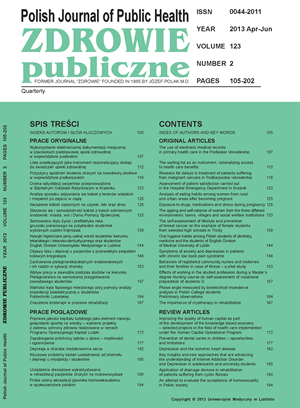Symptoms of anxiety and depression in patients with chronic low back pain syndrome
DOI:
https://doi.org/10.12923/j.0044-2011/123-2/a.10Keywords:
degenerative disc disease, (Intervertebral Disc Degeneration) anxiety, depression, spinal painAbstract
Introduction. Back pain syndromes are some of the most frequent causes of discomfort in contemporary humans, which have health-related, emotional, social and economic consequences.
Aim. The aim of this study was to assess the severity of symptoms of depression and anxiety in patients with chronic low back pain.
Material and methods. The study included 60 patients of the Neurology Unit of the Non-public Healthcare Center Neuro-Psycho-Centrum in Lublin treated for chronic pain syndrome of the lumbosacral spine (30 women and 30 men) and a control group of 60 healthy subjects (30 women and 30 men). All the patients were treated conservatively. The mean age of the patients was 43 years and the mean duration of symptoms was more than two years. The control group was selected randomly from among healthy individuals and was matched to the clinical test group by gender, age, place of residence and level of education. The level of de¬pression in the participants was determined using the Beck Depression Inventory, and the severity of anxiety was tested using Spielberger’s STAI questionnaire.
Results. Statistically significant differences were found between patients with low back pain syndromes and healthy individuals regarding the severity of symptoms of depres¬sion and state and trait anxiety.
Conclusions. Patients with chronic low back pain are characterized by significantly higher levels of state and trait anxiety than healthy controls. Degenerative disc disease pa¬tients suffering from low back pain syndromes have signifi¬cantly higher levels of depression than healthy individuals.The differences in the severity of symptoms of depression and state and trait anxiety between men with lumbosacral spine pain and healthy men are larger than those between female patients and controls
References
1. Brashear HR Jr, Raney RB. Shands’ Handbook of Orthopaedic Surgery. S.Louis: The CV Mosby Co.; 1978. p.136-78.
2. Bogduk M. Management of chronic low back pain. Med J Austr. 2003;180(2):79-83.
3. Casazza BA. Diagnosis and treatment of acute low back pain. Am Fam Physician. 2012;85(4):343-50.
4. Bernard TN, Kirkaldy-Willis WH. Recognizing specific characteristics of nonspecific low back pain. Clin Orthop Relat Res. 1987;217:266-80.
5. Kuslich SD, Ulstrom CL, Michael CJ. The tissue origin of low back pain and sciatica: a report of pain response to tissue stimulation during operations on the lumbar spine using local anesthesia. Orthop Clin North Am. 1991;22(2):181-7.
6. Dziak A. Bóle krzyża. Warszawa: Wydawnictwo Lekarskie PZWL; 1996.
7. Parnowski T, Jernajczyk W. Inwentarz depresji Beck w ocenie nas¬troju osób zdrowych i chorych na choroby afektywne. Psychiatr Pol. 1977;11(4):417-21.
8. Siek S. Wybrane metody badania osobowości. Warszawa: ATK; 1983.
9. Stanisz A. Przystępny kurs statystyki z zastosowaniem STATISTICA PL na przykładach z medycyny. Kraków: StatSoft; 2007.
10. Topolski A, Sapuła R, Topolska M, et al. Częstość występowania depresji u osób z zespołem bólowym dolnego odcinka kręgosłupa. Zam Stud Mater. 2012;1(35):21-5.
11. Kułak W, Kondzior D. Dyskopatia kręgosłupa odcinka lędźwiowo-krzyżowego w korelacji z natężeniem bólu, depresją i akceptacją choro¬by. Probl Hig Epidemiol. 2010;91(1):153-7.
12. Ćwirlej A, Domka-Jopek E, Walicka-Cupryś K, Wilmowska-Pietruszyńska A. Problem rehabilitacji pacjentów z przewlekłym bólem dolnego odcinka kręgosłupa. Przegl Med Uniw Rzesz. 2007;4:355-9.
13. Lenart-Domka E, Bejer A, Probachta M. Zaburzenia depresyjne u pacjentów rehabilitowanych z powodu przewlekłego zespołu bólowe¬go kręgosłupa w odcinku L-S. Young Sport Sc Ukr. 2010;5(3);100-6.
14. Jabłońska R, Swincow A. Stan emocjonalny chorych leczonych operacyjnie z powodu dyskopatii kręgosłupa. Piel Neurol Neurochir. 2012;1(3):103-8.
15. Roch-Radziszewski R. Analiza objawów depresyjnych u pacjentów z dyskopatią lędźwiową leczonych zachowawczo bądź operowanych. Post Psychiatr Neurol. 2006;15(2):77-81.
16. Turkiewicz-Maligranda A, Rymaszewska J. Lęk i depresja a odczuwany ból u osób z chorobą dyskową odcinka krzyżowo-lędźwiowego charakteryzujących się różnym stylem przywiązania. Piel Zdr Publ. 2012;2(4):277-86.
17. Jodzio K, Nyka W, Tomczak H. Depresja u pacjentów z zespołami bólowymi okolicy lędźwiowo-krzyżowej leczonych ambulatoryjnie. Psychiatr Pol. 1995;29(6):809-18


